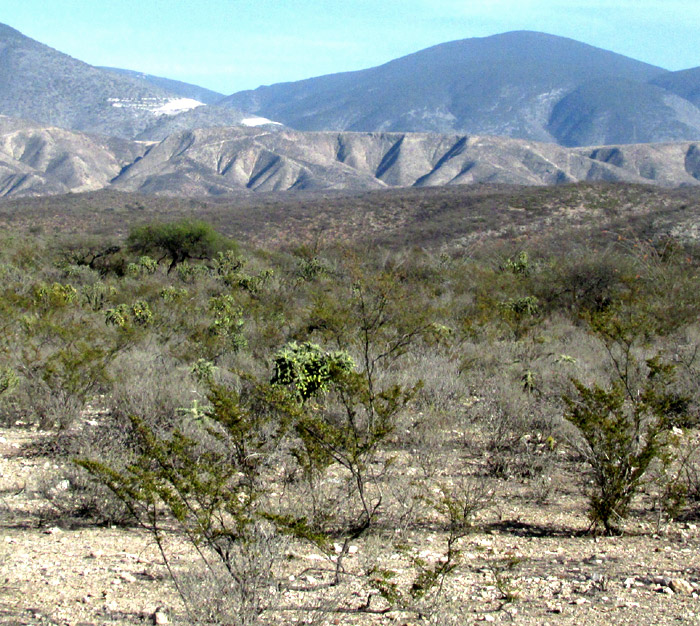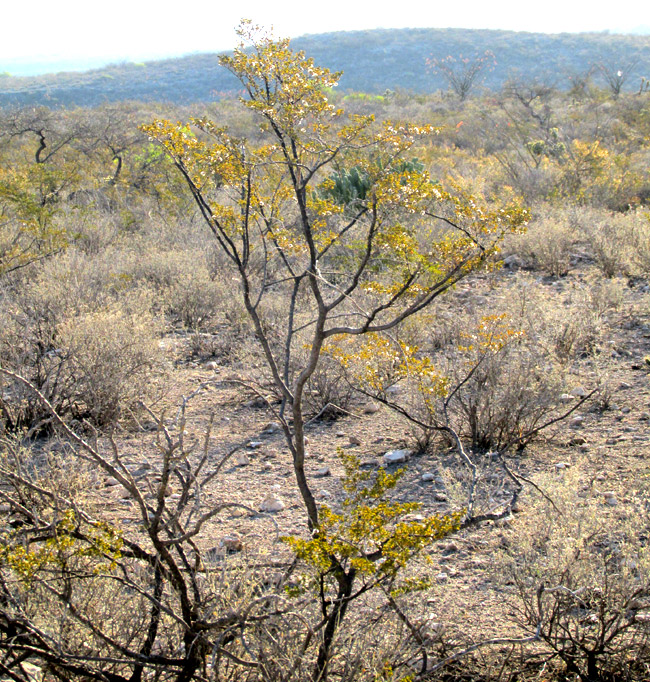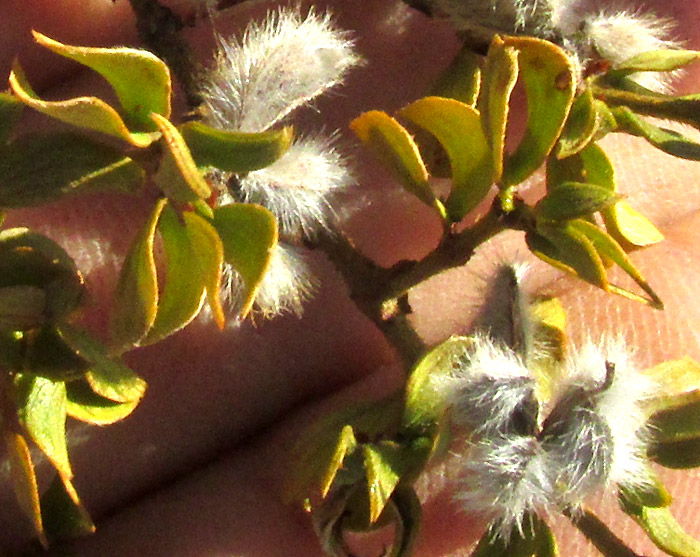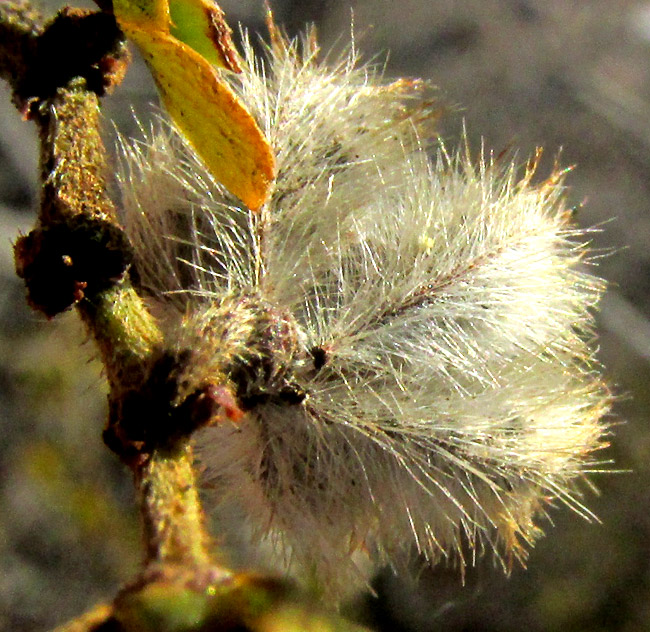Excerpts from Jim Conrad's
Naturalist Newsletter
Entry dated March 7, 2024, from notes taken about 2kms south of Higuerillas, Municipality of Cadereyta de Montes; N20.8884°, W99.7691°, elevation ~1660 meters (~5450 feet); soil derived from unconsolidated mixed-size particles and sand deposited during the late Pliocene and early Pleistocene epochs; local narrow belt of vegetation constituting an extreme southern extension of the Chihuahuan Desert, Meridional Subregion; central Querétaro state, MÉXICO
CREOSOTE BUSHES

From atop a hill 2kms south of Higuerillas, the above plain gently sloping downward toward the east was thickly populated with the shoulder-high, somewhat wiry and scraggly looking, widely spaced, dark-green-leafed shrubs visible in the above picture's foreground. They were Creosote Bushes, LARREA TRIDENTATA, a species evoking vivid memories from my days in 1988 when I gathered experiences for my Spring Comes to the Desert Southwest book. Creosote Bushes are "indicator plants" of the Mojave, Sonoran and Chihuahuan Deserts, often growing in abundance.

The region was enduring a continuing two-year-long dry period classified by the North American Drought Monitor as a D3 Extreme Drought. This may explain why leaves on the above branches are a bit yellowish, and the branches themselves are sparsely leafed. Note the small, white spherical items among the leaves. Here's a close-up:

The white items are split-open, schizocarp-type fruits covered with long, woolly hairs. Schizocarps are dry fruits which split into single-seeded parts when mature. The one-seeded, sections are called mericarps, and Creosote Bush schizocarps split into five of them. In the above picture, at the top, left corner, three spreading-apart mericarps are visible. At the lower, right, a splitting schizocarp is viewed from above. The shrub's leaves, which arise in pairs opposite one another along the stems, are described as pinnately compound and consisting of just two leaflets. That's a little unusual for compound leaves in general, plus Creosote Bush leaves are particularly distinctive because the two leaflets join together at their bases; they look like simple leaves with two half-moon-shaped lobes.

The above shows the dense hairiness of both a young stem and a schizocarp's spreading mericarps. Such hairiness certainly protects parts from water loss, overheating, and sunburn.
Among Creosote Bush's other adaptations to desert conditions is that its leaves are coated with a waxy substance reducing water loss. Also, the leaves are small, which helps prevent them from heating above the surrounding air temperature, which encourages water loss. As our pictures testify, under severe drought stress the bushes lose some of their leaves. However, if all leaves are lost, the plant generally dies.
Creosote Bush's odor is what's memorable: It smells of creosote, much used as a wood preservative, as on railroad ties. The creosote preservative isn't made from Creosote Bushes, but the plants do produce certain chemical compounds known as terpenes which smell like creosote. If you camp among Creosote Bushes and it rains overnight, the next morning the odor of creosote can be extremely powerful.
Smelling so "medicinal," it's not surprising that Creosote Bush has a long history of being used as a traditional herbal medicine. The 2005 study by Silvia Arteaga and others entitled "Larrea tridentata (Creosote bush), an abundant plant of Mexican and US-American deserts and its metabolite nordihydroguaiaretic acid," says that, although controversial, the species "... is used to treat a variety of illnesses including infertility, rheumatism, arthritis, diabetes, gallbladder and kidney stones, pain and inflammation," plus it's been used as a nutritional supplement. As such, often it's marketed as "Chaparral," though it doesn't grow in the plant community known as chaparral. There are reports of damage to the kidneys and liver if regularly used.
The online Atlas de las Plantas de la Medicina Tradicional Mexicana, which calls the plant gobernadora, reports that in traditional Mexican medicine the plant is used mainly for kidney stones and other kidney ailments and cystitis. Branches or the entire plant are boiled in water, which is drunk. Other uses include curing female sterility, rheumatic pains, anemia, colds, diabetes, headache, cough, ulcers, high blood pressure, poor digestion, stomach pain, body swellings and inflammations, muscle pain, malaria and foot infections.
On chilly, foggy mornings in the desert when my sinuses clogged up, I've brewed Creosote Bush tea over a campfire, which cleared the sinuses quite nicely, though maybe just hot water would have accomplished the same.